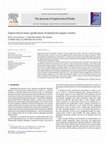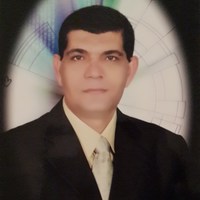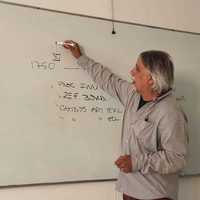Papers by J. Sánchez-Oneto
The Journal of Supercritical Fluids
Journal of Supercritical Fluids, 2017

Applied Sciences, 2020
Supercritical Water Gasification (SCWG) has the capacity to generate fuel gas effluent from wet b... more Supercritical Water Gasification (SCWG) has the capacity to generate fuel gas effluent from wet biomass without previously having to dry the biomass. However, substantial efforts are still required to make it a feasible and competitive technology for hydrogen production. Biomass contains cellulose, hemicellulose and lignin, so it is essential to understand their behavior in high-pressure systems in order to optimize hydrogen production. As the main component of biomass, cellulose has been extensively studied, and its decomposition has been carried out at both subcritical and supercritical conditions. Most previous works of this model compound were carried out in batch reactors, where reaction times normally take place in a few minutes. However, the present study demonstrates that gasification reactions can achieve efficiency levels of up to 100% in less than ten seconds. The effect of temperature (450–560 °C), the amount of oxidant (from no addition of oxidant to an excess over stoi...

Supercritical Fluid Technology for Energy and Environmental Applications, 2014
ABSTRACT Supercritical water oxidation (SCWO) is a promising technology that respecting the envir... more ABSTRACT Supercritical water oxidation (SCWO) is a promising technology that respecting the environment destroys wastes definitely and allows an energy recovery. This process has been applied to many model compounds and real wastewaters at laboratory scale. However SCWO treatments at pilot plant scale of real wastewaters are much more limited in literature. Furthermore, the application of this technology to industrial wastewaters has some drawbacks as corrosion, salt deposition, management of biphasic wastes, presence of suspended solids and high costs, so nowadays the industrial scale-up is scarce and it is being delayed. As an attempt to reduce process costs, energy recovery from the effluent of the reactor has been studied by several authors. In this chapter, the main aspects of the SCWO are briefly described and the studies regarding energy recovery are summarized.

Reviews in Chemical Engineering, 2005
Esta pesquisa foi realizada em um Serviço Pediatria Geral, na cidade de Maceió, com 28 cuidadores... more Esta pesquisa foi realizada em um Serviço Pediatria Geral, na cidade de Maceió, com 28 cuidadores de crianças hospitalizadas, tendo como objetivo investigar a qualidade de vida desses acompanhantes, seu sofrimento psíquico no ambiente hospitalar, os determinantes desse sofrimento, seus mecanismos e manifestações. Foi realizada uma análise descritiva dos dados, com distribuição de freqüência sóciodemográfica, dados sobre a doença, análise quantitativa e qualitativa dos itens da entrevista semi-dirigida, dos itens do SF 36 e do HADS. Verificamos que a cronicidade do quadro da criança é o fator que mais influencia na qualidade de vida de seus acompanhantes, que o grau de parentesco entre criança e cuidador, a renda familiar, estado civil dos cuidadores não influenciaram a qualidade de vida dos mesmos; que o convívio com a doença há mais de um ano e a idade superior a 30 anos influenciaram negativamente essa qualidade de vida. Palavras-chave: cuidadores; qualidade de vida; hospital.

The Journal of Supercritical Fluids, 2013
A supercritical water oxidation (SCWO) process with oxidant multi-injection was studied in a cont... more A supercritical water oxidation (SCWO) process with oxidant multi-injection was studied in a continuous flow system in which the same amount of oxidant feed is split between two points-a first injection at the reactor inlet and a second injection at one of the three different positions along the reactor. Under the same operating conditions, this multi-injection configuration showed advantages over the system with a single oxidant entry. Moreover, oxidant dosage in a SCWO reactor is a key aspect in energy management. In this work, experiments were performed to find the best oxidant dosage to obtain the maximum organic conversion. Experiments were carried out using N,N-dimethylformamide (DMF) as a model compound for nitrogen-containing hydrocarbons in wastewaters. All experiments were carried out at 250 bar with an oxygen coefficient n = 1 and a temperature of 400 • C. Each experiment was carried out at five different residence times (2, 4, 6, 8 and 10 s). Once the best configuration had been determined, the effect of temperature (400-550 • C), initial organic concentration (5-30 mM), oxygen coefficient (0.5-3) and residence time (2-10 s) was investigated in the SCWO process of DMF.

Journal of Hazardous Materials, 2007
The aim of this work is to present the application of the hydrothermal oxidation in supercritical... more The aim of this work is to present the application of the hydrothermal oxidation in supercritical conditions, also named supercritical water oxidation (SCWO) to the treatment of two commercial cutting fluids: Biocut ® and Servol ®. Experiments were carried out in a continuous flow system at a constant pressure of 25 MPa, using pure oxygen as oxidant in excess, and different temperatures ranging from 673 to 773 K. Both semi-synthetic cutting fluids are a mixture of several compounds so the efficiency of the oxidation process was followed in terms of the reduction in chemical oxygen demand (COD) and total organic carbon (TOC). A comparison of the results obtained in the study showed that it is possible to apply successfully SCWO for both cutting fluids, obtaining more than 95% for both COD and TOC removal at 773 K. However, the results also show that different residence times are needed to obtain the same percentage of COD or TOC removal depending on the cutting fluid treated, being in all cases Servol ® easier to oxidize than Biocut ®. A kinetic model to predict COD and TOC conversion has been proposed for both cutting fluids. A two-parameter mathematical model involving two steps (a fast reaction followed by a slow reaction) was used to describe the Biocut ® SCWO kinetics and to calculate the kinetic constants.

The Journal of Supercritical Fluids, 2008
Supercritical Water Gasification (SCWG), in which supercritical water is not only a solvent for o... more Supercritical Water Gasification (SCWG), in which supercritical water is not only a solvent for organic materials but also a reactant, is one of the applications for producing fuel from organic resources. In this way, besides the destruction of wastewaters, it is aimed to harness their energy potential by burning the gas effluent generated in the process, which contains a high level of heating power due to its high content in hydrogen and light hydrocarbons. In the work described here, SCWG has been tested on a laboratory scale continuous-flow system with two different industrial wastewaters that contain a high concentration of organics, with both wastes having a high energy potential: cutting oil wastes, oleaginous wastewater from metalworking industries, and vinasses, alcohol distillery wastewater. Reports on SCWG processes on these types of wastewaters have not previously been published in the literature. The influence of the temperature, amount of oxidant and catalyst addition on the yield and composition of the gas phase generated were studied. Experiments were carried out in the temperature range 450-550 • C, the amount of oxidant ranged from the absence of oxygen (oxygen coefficient, n = 0) to 20% of stoichiometric oxygen (n = 0.2), and 250 bar of pressure in all cases. A maximum of 0.19 mol H 2 per initial COD m (COD m is given as mol O 2 consumed for total oxidation) was obtained in the gas phase under the best conditions.

The simulation of the Supercritical Water Oxidation (SCWO) process is a crucial step to optimize ... more The simulation of the Supercritical Water Oxidation (SCWO) process is a crucial step to optimize and to scale up this process. A simulator ll ws us to know easily the optimization of changes in operating conditions and the performa nce of new modifications previous to their implementation in the process. Many attempts have been carried out successfully to simulate the SCWO process in steady state, however, only a transitory state simulation is suitable to explore the start-up and to reduce its nergetic requirements. The software used in this work have been both Engin eer g Equation Solver (EES) and Matlab. The combination of both programs is really powerful to solve complex engineering problems and simulations involving thermodynamical properties. The main development of the model has been carried out with Matlab, and EES has been used to determinate the properties of compounds, because EES counts on a hu ge thermodynamical properties and models database for many compounds. In this ...
Supercritical water oxidation (SCWO) is a powerful green technology to treat hazardous wastewater... more Supercritical water oxidation (SCWO) is a powerful green technology to treat hazardous wastewaters. This process has been extensively studied for decades from laboratory scale studies of model compounds to several demonstration and industrial plants under construction worldwide. However, SCWO treatments at pilot plant scale of real wastewaters are much less extensive in literature. Furthermore, the application of this technology to industrial wastewaters has two main drawbacks such as corrosion and salt deposition, and some other problems to be solved related to management of biphasic wastes, presence of suspended solids, high costs, etc.; and therefore, currently, the industrial scale-up and commercialization of this process is still subject to difficulties.

Applied Sciences
The use of micro- and nanoparticles is gaining more and more importance because of their wide ran... more The use of micro- and nanoparticles is gaining more and more importance because of their wide range of uses and benefits based on their unique mechanical, physical, electrical, optical, electronic, and magnetic properties. In recent decades, supercritical fluid technologies have strongly emerged as an effective alternative to other numerous particle generation processes, mainly thanks to the peculiar properties exhibited by supercritical fluids. Carbon dioxide and water have so far been two of the most commonly used fluids for particle generation, the former being the fluid par excellence in this field, mainly, because it offers the possibility of precipitating thermolabile particles. Nevertheless, the use of high-pressure and -temperature water opens an innovative and very interesting field of study, especially with regards to the precipitation of particles that could hardly be precipitated when CO2 is used, such as metal particles with a considerable value in the market. This revi...
The Journal of Supercritical Fluids

The Journal of Supercritical Fluids
Abstract One of the factors against the upscaling of SCW plants is the enormous amount of energy ... more Abstract One of the factors against the upscaling of SCW plants is the enormous amount of energy demanded during the start-up phase to reach the stationary state and the autothermic operation phase. This work proposes a new strategy with a lower energy cost and, consequently, with a smaller initial investment. It consists on statically heating up different sections in an SCWO plant by means of electric heaters distributed throughout the plant. A constant temperature of 400 °C can be reached in a plant containing a mixture of water and ethanol at near critical pressure. Then, when the feed and the oxidant are pumped, the oxidation reactions starts. Such reaction, in turn, releases the heat required for autothermal operation. The experiments that have been carried out have confirmed that the Low Power Static-heating Start-up Procedure (LPSSP) proposed would mean a saving of 46.4% in power consumption when compared to a conventional start-up procedure.








Uploads
Papers by J. Sánchez-Oneto